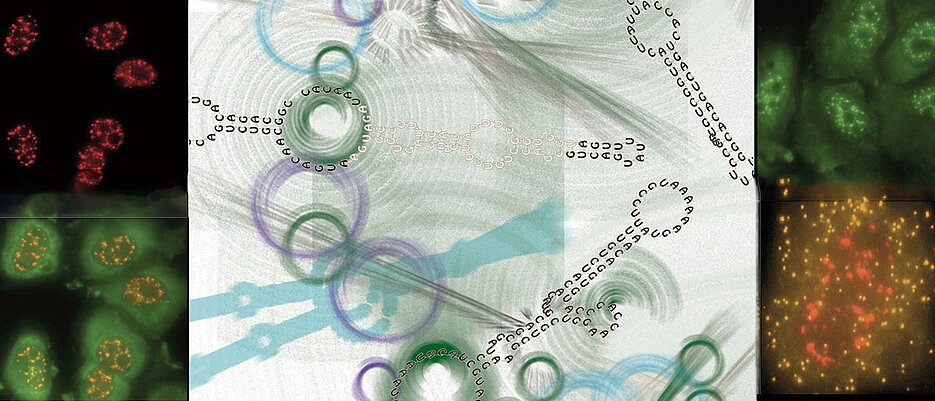More than 1,000 players are involved in a cell when genetic information is translated into proteins. A new German-Israeli research project is now working on systematically identifying their respective tasks.
When genetic information in human cells is transported from the cell nucleus into the cytoplasm and translated into proteins, one particular molecule plays a central role: mRNA, or messenger RNA. However, in order for this mRNA to do its job according to plan, it needs a lot of support. In recent years, scientists have identified around 1,000 different participants that are involved in this process.
A new German-Israeli research project has set itself the goal of deciphering their function and structure in detail. Research groups from the universities of Regensburg and Würzburg and the Weizmann Institute of Science in Israel near Tel Aviv are involved in the project. Professor Utz Fischer, holder of the Chair of Biochemistry, is at Julius-Maximilians-Universität Würzburg (JMU) responsible for the project.
Essential for the functioning of every living organism
“At the heart of our research project is the question of the stability of mRNA molecules” explains Utz Fischer. After all, stability has a significant effect on function, partly because the quantity of the encoded proteins depends on it. Little is known about how the stability of long RNAs is determined by the interplay of sequence, structure, chemical modifications and RNA-binding proteins. Yet this interplay is essential for the functioning of every organism.
“When the genetic information of the DNA is read in the cell nucleus, an immature mRNA strand is initially produced,” explains Fischer. During the maturation process, numerous proteins then attach themselves to the strand in various combinations and initiate the necessary steps. They accompany the mRNA throughout its entire lifetime and ensure its degradation at the end. mRNP, or messenger ribonucleoproteins, is the name given to these units composed of mRNA and associated proteins; with their variety of combinations, they form an extremely complex network.
Extremely cramped conditions
What makes research on this network even more complicated: “These processes are never static. Rather, it is an extremely dynamic matter that must be perfectly orchestrated” says Fischer. During the lifetime of an mRNA strand, which only lasts a few minutes to a few hours at most, it must be ensured that the necessary proteins are present and active at exactly the right time throughout the entire process. Once they have fulfilled their tasks, they must withdraw and leave the stage to other players. “How this can work under the extremely cramped conditions inside the cell, is really puzzling” says the biochemist.
Of course, it is not the case that every time a gene is read, and a messenger RNA is sent on its way, 1,000 developmental helpers are involved in the process. “The composition varies greatly. In a muscle cell, completely different RNA-binding proteins are used compared to a liver cell, for example,” says Fischer. However, the principle is the same across all cells; RNA-binding proteins form the basis for all biochemical processes.
New findings for new vaccines
The findings that Fischer and his colleagues hope to gain in the coming years are correspondingly broadly applicable. Ultimately, conclusions can be drawn about the normal and defective development of organisms. The processes play a role in infections and in the development of tumours. And they are also relevant for the development of new vaccines.
“As the coronavirus pandemic has shown, mRNAs are hugely important for the development of new vaccines,” explains Utz Fischer. An understanding of sequence elements and mRNA modifications is a prerequisite for the design of stable mRNAs that work according to plan. For this reason, the four research groups will not only investigate the function of RNA-binding proteins. Their program also aims to identify and test stabilizing and destabilizing RNA elements and modifications.
1.6 million euros for five years
The research project “Quantitative and mechanistic dissection of messenger RNA stability” is scheduled to run for five years; the four groups involved have a total of 1.6 million euro at their disposal. In addition to Utz Fischer, the following scientists are involved: Professor Gunter Meister, Institute of Biochemistry, Genetics and Microbiology at the University of Regensburg, as well as Professors and RNA experts Igor Ulitsky and Schraga Schwartz from the Weizmann Institute of Science in Israel.
The project is funded by the Federal Ministry of Education and Research (BMBF); the scientific and administrative responsibility – and therefore also the decision on approval – lies with the German Research Foundation DFG within the framework of the German-Israeli Project Cooperation (DIP). “The quality of the research work and the strength of the scientific cooperation, including the exchange of scientists, especially young researchers, are the main criteria for the evaluation and selection,” according to the DFG’s website.









